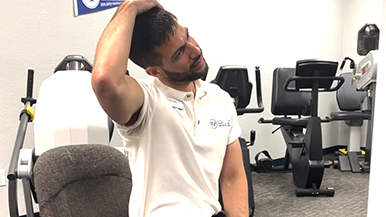 What happens when the pelvic floor fails?
What happens when the pelvic floor fails?
- Why would I have problems with my pelvic floor?
- How do doctors diagnose a problem with your pelvic floor?
- What is pelvic floor therapy?
The pelvic floor is the group of muscles that support organs in the reproductive, urinary, and digestive systems. Pelvic floor muscles wrap around these important organs and attach to the pelvis and tailbone of the spine. When the pelvic floor starts to malfunction, you can experience pain and bladder or bowel incontinence as well as other issues.
Fortunately, pelvic floor therapy allows physical therapists to treat the pelvic floor. This resource will help you understand these muscles and the therapies that we can use to help repair the damage your pelvic floor may experience.
What Happens When the Pelvic Floor Fails?
When the pelvic floor fails, urination, bowel movements, and even sexual intercourse can be affected. One in five people will experience problems with the pelvic floor in their lifetimes. If you leak urine when working out or have trouble releasing a bowel movement, it may be time to have a professional examine your pelvic floor.
The pelvic floor is a complex funnel made up of three sheets of muscles that form a kind of a sling for the internal organs in your pelvic region. In women, the pelvic floor supports the anal canal, urethra, and vagina. In men, these muscles support the bowel and bladder.
The muscles that make up the pelvic floor have an important job that we often take for granted until they fail us. One of its functions is as part of the core muscle structure of the body, controlling your posture and the position of your internal organs. In this role, these muscles work with the muscles in your back to help you stand up upright without any sort of fatigue. A second function of the pelvic floor muscles is working together to contract and relax the pelvis so you can control bladder and bowel functions. These muscles are also involved during orgasm.
When the pelvic floor muscles don’t work, you can experience several very uncomfortable, possibly embarrassing, and life-altering symptoms, such as the following.
Urinary tract problems
- High frequency of urination or an urgent need to urinate
- Leaking urine
- Painful urination
- Difficulty stopping or starting urination
- Problems fully emptying the bladder
- Erectile dysfunction
Bowel issues
- Painful, straining bowel movements
- Fecal incontinence
Pain-related symptoms
- Pelvic pain
- Genital pain
- Pain in the rectum
- Painful intercourse
Why Would I Have Problems With My Pelvic Floor?

Pelvic floor issues are particularly common with women. Fifty percent of women over age 55 have a pelvic floor disorder. Pregnancy and giving birth are two of the biggest reasons women suffer issues with the pelvic floor muscles (we do have some stretches that can help with that, if you want to check them out).
Other reasons for developing pelvic floor issues include abdominal surgery or radiation to treat cancer that damages these muscles. Even a history of moving or lifting heavy loads could cause problems with your pelvic floor. Traumatic injury to the pelvic region and even weight gain and advancing age can be a factor in developing this condition.
How Do Doctors Diagnose a Problem With Your Pelvic Floor?
Your healthcare provider will conduct a thorough history and exam to rule out other issues. Some typical questions may include:
- Do you have frequent infections in your urinary tract?
- Have you given birth?
- For women, do you have pain during sex?
- For men, do you have problems with your erection?
- Do you strain when passing a stool?
- Do you leak urine when sneezing or exercising or at other times?
Your doctor may do a physical exam to check inside and outside the pelvic area to look for weakness, spasms, or other signs of injury or illness. You may have one or more tests such as:
- Anorectal manometry to measure if and how well the anal sphincters work in your body
- Defecating proctogram, which requires an enema of a liquid then a video X-ray to measure muscle movements as you expel the fluid
- Uroflow test to measure how well you empty your bladder
From these tests your doctor will work with you to develop a treatment protocol to help your situation improve.
What Is Pelvic Floor Therapy?

Should your doctor refer you to a physical therapist for treatment, it’s normal to feel nervous at first, especially if you aren’t quite sure what to expect from your first visit to a pelvic floor physical therapist. Pelvic floor issues are typically treated in several ways. Two of the most common treatments are biofeedback and physical therapy.
Biofeedback is a process of retraining your muscles to help you relax and strengthen the pelvic floor muscle. The goal is for you to improve bowel and bladder function. During biofeedback sensors are used to monitor the pelvic floor muscles. The sensors are attached to a computer screen. You will work with the physical therapist to tighten and loosen the pelvic floor muscles. Any changes are seen on the computer screen. Biofeedback retrains the body to begin to take back control of the muscles in the pelvis area. You’ll also have exercises to do at home. This is usually coupled with diet and exercise suggestions to help improve the quality of your life.
Physical therapy may include internal and external treatments designed to work on the muscles. Given the sensitive nature of these physical manipulations, your physical therapist will work with you to design a treatment plan that you’re comfortable with. This could include:
- Stretches to strengthen the pelvic muscles, legs, and trunk
- Deep tissue massage
- Trigger point therapy
- Relaxation exercises for pelvic muscles that have tightened or shortened
- Education in how to prevent further weakening of these muscles
- Exercises to strengthen your core and improve your coordination
In addition to physical manipulation, biofeedback, and exercises, you may also have ice or heat applied to the area to help relieve pelvic pain. You may also use medications that keep your stool soft. You’ll learn to get in touch with the muscles in the pelvis and learn to contract and then relax these muscles. This strengthens weakened pelvic floor muscles to restore normal function.
There is no surgery to treat pelvic floor dysfunction because the issue is related to your muscles. However, your physical therapist is trained in treating this disorder. Pelvic floor physical therapy is very effective at providing improved function of these muscles and ultimately, better quality of life.
If you’re suffering from any of the symptoms described in this article, or have been diagnosed with pelvic floor issues, talk with the pelvic floor therapy team at Ability Rehabilitation. We are highly experienced in pelvic floor treatment, and we are eager to help you get back to moving and living your life without the pain and discomfort of these conditions.



